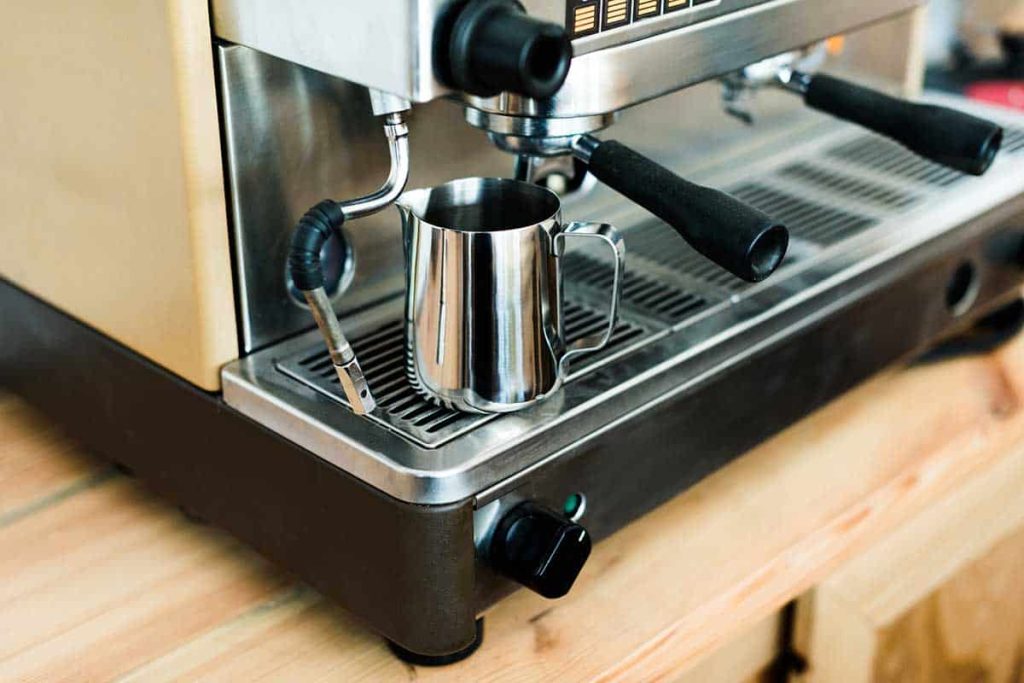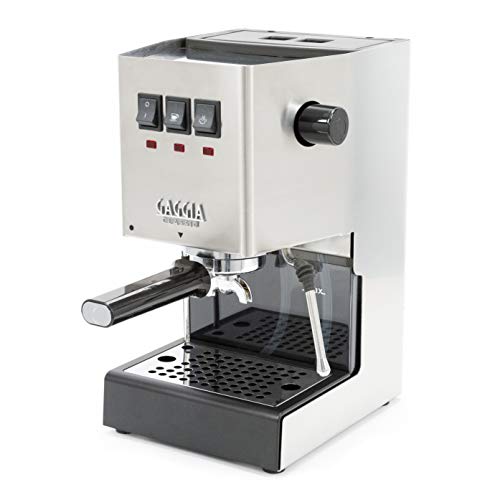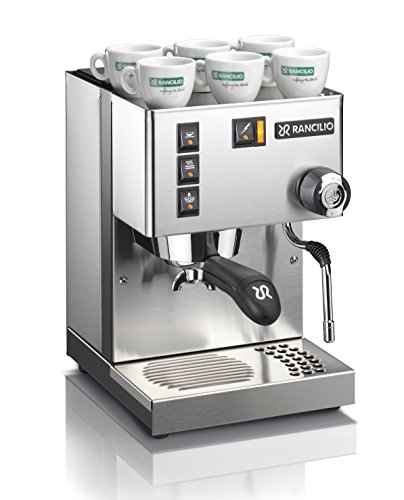The Best Prosumer Espresso Machines + Reviews

Picture a hybrid espresso maker that combines the best of what basic and higher-end models offer. Interesting idea, right? Well, I have some good news. Today, I’ll show you what the best prosumer espresso machine is.
Maybe you are wondering what “prosumer” means. Just to clear your doubts, that’s not a brand; the name refers to professional espresso machines designed for home use. I’ll be telling you more about them shortly.
Meanwhile, I want you to forget about the usual espresso maker you use at home for a moment. Prosumer coffee machines are way better than that. But since this is a competitive market, there can only be winners and losers.
My focus today is on the winners, and as usual, I’ll show you who takes the crown, and then I’ll dive into the runner-ups.
TOP PICK
Breville BES870XL offers so much for less without compromising on performance. That’s a balance you don’t see often. It’s automatic, but if you prefer a hands-on approach, there’s a semi-automatic setting option for you. It’s also fast, and more importantly, it’s capable of brewing great-tasting espresso for everyone in your family, office, or group.
My Best Prosumer Espresso Machine Reviews
| Product | Key Features | |
|---|---|---|
Best Overall  |
Breville BES870XL Barista Express
|
Check Amazon |
Best Budget  |
Gaggia RI9380/46 Classic Pro
|
Check Amazon |
 |
Rancilio Silvia
|
Check Amazon |
 |
De’Longhi La Specialista
|
Check Amazon |
 |
La Pavoni PC-16
|
Check Amazon |
1. Breville BES870XL Barista Express Espresso Machine
Breville BES870XL Barista Express Espresso Machine
Key Features
- 15-bar pump pressure
- Automatic
- Rotary pump
- Thermocoil heating system
- Built-in grinder
- Manual steam wand
- 67 oz (2 L) water tank
- Brushed stainless steel body
Even though it’s not the best in the Breville series, the BES870XL brews like a pro. Give it your freshly roasted beans, and you will have your rich, full flavored shots in under a minute, thanks to the thermocoil heating system. Frothing may not be as fast as brewing, but the smooth and tasty microfoam milk you get totally compensates for that.
Like many coffeeholics, I couldn’t help but get excited at the built-in grinder. It saves you time and effort, but more importantly, you get ultimate control over the dosage. All you have to do is tune the dial to a grind size of your liking.
Speaking of customization, you can also make either single or double shots and even perfect the temperature and water level. Who wouldn’t like that? That’s the magic behind the PID feature and low-pressure pre-infusion technology.
Breville BES870XL is also beginner-friendly. It won’t take you long to figure it out because it’s a semi-automatic model.
Pros
- Decent control over the brewing process
- Easy to use
- Makes rich espresso with perfectly balanced flavors
- Manual steam wand gives you control over the milk frothing process
- Plenty of accessories that intensify your brewing experience
- Operates silently
Cons
- Slow milk frothing process
Looking at its price, one can’t help but clearly see the great value you get from this espresso machine. It offers so much for less and performs exceptionally well as a prosumer coffee maker.
Check Amazon2. Gaggia RI9380/46 Classic Pro Espresso Machine
Gaggia RI9380/46 Classic Pro Espresso Machine
Key Features
- 12-bar pressure
- Semi-automatic
- Vibratory pump
- 72 oz (2.1 L) water tank
- Chrome-plated brass boiler
- Commercial steam wand
- Stainless steel housing
It’s easy to mistake Gaggia RI9380/46 for a purely commercial espresso machine. Most of its features are common in top-of-the-line models, but it’s a prosumer machine that will save you from having to take a trip to a coffee shop to experience barista-brewed coffee.
Most semi-automatic models take a minute or less to steam, but Gaggia RI9380/46 does it in only 30 seconds or less. And with its commercial steam wand, you get full control while frothing or steaming milk.
Brewing doesn’t last more than five minutes with this unit, and Gaggia topped up the experience by availing both the pressurized and commercial filter basket. That’s why this espresso machine can make cafe-quality espresso from different coffee beans. Also, it has a control panel with only three switches, so it won’t take you long to figure things out.
Unlike most prosumer machines, Gaggia RI9340/46 is designed to last. The best part is that its stainless steel housing isn’t just functional but also aesthetically appealing. It’s an appliance that’s going to serve you well while also adding to the beauty of your kitchen.
Pros
- Commercial style portafilter that can endure high-volume situations
- Stainless steel frame that serves both functional and aesthetic purposes
- Pump mounts that minimize vibrations
- Easy to use
- Versatile steam wand
- Plenty of extra features for optimizing the machine’s capabilities
Cons
- Can’t accommodate cups that are not less than 3.5 inches
Gaggia RI9380/46 may not be as capable as the machines with dual boilers and rotary pumps, but it does the job. It’ll get you consistent quality shots and serve you for a longer time.
Check Amazon3. Rancilio Silvia Espresso Machine
Rancilio Silvia Espresso Machine
Key Features
- Semi-automatic
- 9-bar pressure
- Vibratory pump
- Single brass boiler
- Holds 12 oz (0.3 L)
- Saturated group head
- Articulating steam wand
- Optional capsule/pod adaptor kit
Rancilio Silvia borrows a lot from the brand’s premium models, from the group head and volume capacity to the filter and classic linear design. But it’s not all about performance and looks; I was greatly surprised by its toughness and ease of use.
It may be traditional, but the Rancilio Silvia rivals its modern counterparts. It’s a lever-operated machine that will brew your coffee and steam your milk in no time. Even though it can’t do both tasks simultaneously, the chrome-plated brass boiler makes decent steaming power and can pull espresso shots back to back.
Brewing is a whole other experience, and this performance is majorly attributed to its commercial-grade group head. It maintains the heat, has no fluctuations, and also does the extraction as any premium model would.
Back in the intro, I told you that this unit can take a beating. Credit for that goes to its stainless steel panels and iron frame. It’s not hard to see that this thing was built to last.
Pros
- Features a patented portafilter that contributes to the superior extraction quality
- Lasts longer
- Higher volume capacity
- Steam wand offers a complete range of motion
- Design and looks will easily complement most decors
- Removable water reservoir that’s easy to fill
- Relatively affordable
Cons
- Sprout cannot accommodate bigger cups (like a mug)
Rancilio Silvia may share price with a good number of entry-level espresso makers, but its exceptional performance and abilities qualify it as a prosumer coffee machine worth your money.
Check Amazon4. De’Longhi La Specialista Espresso Machine
De’Longhi La Specialista Espresso Machine
Key Features
- 19-bar pressure
- Semi-automatic
- Dual heating system
- Built-in grinder
- 67.6 oz (1.9 L) water tank
- Automatic milk-steaming
- Vibratory pump
- Separate hot water spout
Very few espresso machines blend simplicity and performance as perfectly as De’Longhi La Specialista does. You have a coffee maker that’s simple to use and at the same time a beast at handcrafting the ultimate espresso shots.
You will immediately realize De’Longhi left no stone unturned in designing this model to make barista-quality beverages. It wasn’t enough to have a built-in grinder, so they innovated this part further by adding a grinding technology that would ensure you get consistent grinds and perfect doses for your espresso.
As it pulls shots, you can also activate the steam wand to texture your milk. What makes this possible is the dual heating system where one thermoblock extracts your coffee and the other independent heating system steams your milk.
Americanno fanatics also haven’t been left out. The separate hot water spout has you covered.
Pros
- Automatic steam wand lets you choose your preferred froth style between rich foam and micro foam
- Lets you tamp your grounds for perfect results
- No additional heat time needed to make a latte or cappuccino
- Versatile coffee maker
- Produces little waste, thanks to the smart tamping station
- Accommodates different mug sizes
- Easy to set up and use
Cons
- Not ESE compatible
I’m not sure about you, but I value versatility and exceptional performance. That’s what draws me to the De’Longhi La Specialista. If you share the same interests, this machine will be perfect for you.
Check Amazon5. La Pavoni PC-16 Professional Espresso Machine
La Pavoni PC-16 Professional Espresso Machine
Key Features
- Manual
- Single boiler
- 16-cup capacity
- Steaming mechanism for making cappuccino
La Pavoni is the brand behind some of the world’s best lever espresso makers. La Pavoni PC-16 is no different. Just like its forerunner, the Europicca, this model has risen to become the go-to manual espresso machine for coffee enthusiasts.
Compared to its predecessor, La Pavoni offers more, from double the capacity to improved pressure control. You will cherish it if you have a larger family and enjoy having plenty of control over the brewing process.
Because it’s a lever machine, you will have to lift it for water to make its way into the filter holder and then lower it down to force the water through the ground coffee. The addition of a pressure gauge (manometer) makes it even easier to customize the extraction and pressure to your liking.
As for steaming, two options are available to you: the traditional three-hole-tip steam wand and an auto-frothing attachment. The former is for lattes while the latter is perfect for cappuccinos.
Pros
- Attractive design that can complement most interior decors
- Heats up in less than five minutes
- Larger capacity
- Can make both single and double shots
- Detailed instructions (text and video) to help you optimize the machine’s capabilities
Cons
- Extra height needed to accommodate the lever’s height
What qualifies La Pavoni PC-16 as a prosumer coffee maker is the professional style in which it is made. Count on it to make you barista-style espresso, cappuccino, and latte with little effort.
Check AmazonWhat’s a Prosumer Espresso Machine?
Prosumer is a blend of two words: professional and consumer. You could easily guess what this means. Essentially, that’s a professional-grade coffee machine designed for consumers.
It would be safe to say no other espresso maker caters to the needs of coffee enthusiasts as perfectly as a prosumer coffee machine does. Count on them to not only make you barista-quality beverages but also provide you with the dream coffee brewing experience.
But as you probably noticed, prosumer devices don’t come cheap, and that’s not a mystery. Great commercial coffee makers cost thousands of dollars, and since these consumer-centric units borrow a lot from them, you wouldn’t expect their price to be on the lower side.
The good news? You get a lot of bang for your buck. I agree with many coffee connoisseurs that this is the best investment you can ever make if your desire is to experience premium rich espresso, complete with all the nuanced flavors.
Maybe you are wondering how to go about shopping for one. Good question! This is a step you should never ignore and you’ll soon find out why. Meanwhile, here’s how to do it.

Choosing the Best Prosumer Espresso Machine
Grouphead Designs
The ideal group head maintains the perfect temperature as it pulls espresso shots. E-61 has been the popular and ideal group head for a long time, but in recent years, the saturated group head has emerged as its rival.
Both offer good temperature stability, but the saturated group head performs way better. E-61 constantly circulates hot water through the pipes between it and the boiler. The saturated group head, on the other hand, is directly connected to the boiler so hot water flows from the boiler straight into the group.
Heating System
Don’t we all want our espresso ready in no time? This is where the heating system comes in.
Some prosumer devices can simultaneously brew coffee and froth milk. Those with dual boiler units are the most consistent in high-volume situations. Also, they provide you with a greater degree of control compared to models that use the heat exchange (HX) mechanism. Unfortunately, they have a bigger footprint and cost more than HX models.
Type of Pump
Prosumer models come with either a rotary or vibrating pump. The former is more common in top of the line models majorly because it:
- Rarely fails
- Makes less noise
- Pulls shots back to back
- Can be plugged directly to a water line
- Gives you a generally better brewing experience
Vibrating pumps, on the other hand, are naturally noisy, but some coffee makers feature a padding that soaks up some of the noise. You will mostly see them in coffee makers for home use partly because they are affordable and easy to find.
Since they combine the best of both worlds, prosumer machines can make use of either pump.
Boiler Material
Common materials used to make boilers include aluminum, copper, brass, and stainless steel. Each has unique attributes that define its performance.
Copper, for instance, is the most expensive and common in premium appliances because of its high thermal conductivity. Aluminum’s thermal conductivity isn’t the best, but it’s cheap and features a lot in cheap espresso makers.
Brass is easy to manufacture and relatively cheaper but still not as good as copper when it comes to thermal conductivity. Stainless steel dominates in popularity because it’s relatively low in price and durable, but it lacks the great thermal conductivity you would find in copper.
Cup Capacity
This purely depends on your needs. Machines with huge water reservoirs will serve you better if you have a large family. You won’t have to refill it often, so check the water capacity as well cup capacity.
Ease of Use
First off, let’s not confuse ease of use and control.
Manual coffee makers can be difficult to use, but the upside is you get a higher level of control. At the same time, there are manual, automatic, and semi-automatic machines that are so sophisticated and just a pain to use, whether you are a novice or seasoned home barista.
An approach I suggest you take is to check the learning curve. In fact, you are better off with a programmable model that lets you personalize your brew with a one-touch button. Some will even save this setting and activate it every time you brew. Isn’t that sweet?
A few other factors you should equally pay great attention to include:
- Ease of cleaning
- Milk steaming (steam boiler size, range of motion, hot water support, etc.)
- Size and weight (dual boiler machines are much bigger than heat exchange models)
- Warranty
- Price
Remember to also check out prosumer espresso machine reviews and ratings on popular shopping websites.
FAQs
Is a prosumer espresso machine worth it?
Anyone who’s eager to brew barista-quality coffee from the comfort of their kitchen will find prosumer espresso machines totally worth it. They borrow the best of what commercial-grade and home-use espresso makers feature to give you a brewing experience and outcomes you wouldn’t normally experience at home. I’m talking about consistent quality shots, exceptional lattes, cappuccinos, higher cup capacity, you name it.
Does a rotary pump make better espresso than a vibratory pump?
None of these pumps is better than the other in brewing quality espresso. You only have to weigh the pros and cons of each, and then you can decide which option is best for you. Just to remind you again, vibratory pumps produce more noise but are cheaper, smaller, and easy to find. Rotary pumps, on the other hand, are expensive but quieter and generally more versatile.
How long does a prosumer espresso machine last?
Generally, espresso machines can last anywhere between seven and 15 years depending on how well you take care of them. But there are also factors out of your control that could affect how long your prosumer coffee maker lasts. Some of them include frequency of use, materials it is made from, the brand of the machine, and how you use the unit.
And the Winner Is…
Breville BES870XL Barista Express Espresso Machine may not tick all the boxes with regard to the factors I mentioned earlier, but it’s the overall best prosumer model because of how it perfectly balances its functions.
Whether you are a novice or coffee connoisseur, operating this machine will be a breeze for you. Its heating system makes coffee and steams milk in less time and to your satisfaction. You also have a water reservoir that is huge enough to serve several people and lots of accessories that help to perfect your brewing experience.
The rest of the options are equally great. It’s up to you to figure out which unit best caters to your specific needs and preferences. For example, if you prefer a strictly manual prosumer coffee machine, La Pavoni PC-16 would be a perfect choice.
All the best as you set off to find the prosumer coffee maker of your dreams!
Owen is a writer and editor at Caffe Streets who considers himself a coffee fanatic. He spends his time researching and testing different coffee beans and brewing methods and sharing what he learns with others.





